
After harvesting, a lot of residues are usually left in the fields that must be painstakingly chopped up and later reincorporated into the soil. That is why, as part of the “Kombimulcher” research project, a project consortium of several universities and companies has developed a modular system that can handle this work in a single step. “Crop residues usually have to be processed in narrow time windows between harvesting the previous crop and sowing the following one. Otherwise, the fungi involved in decomposition threaten the next crop and make chemical treatments necessary,” explains Prof. Wolfgang Kath-Petersen from the Institute for Construction and Agricultural Machinery Technology at Cologne Technical University. “To make processing more effective, we have developed a modular system. This makes it possible to pick up crop residues from grains, rapeseed or corn straw and, depending on the agronomic objective, crush them to varying degrees and mix them into the soil.”
This processing can either accelerate the rotting of the plant material or promote soil conservation, depending on what happens to the field afterwards. If the seed for the next crop is sown immediately after harvesting, the crop residues are chopped up very finely and mixed in shallow soil. This reduces the risk of disease or pest infestation because rotting starts quickly. However, if the field is to lie fallow over the winter, the plant material is processed rather coarsely. This causes the residues to rot more slowly, protecting the bare soil better from erosion.
Successful field trials
The system consists of a conventional mulcher equipped with additional tools so that the crop residues can be processed differently and mixed with the soil. “We developed a module with rotating star-shaped tools,” Kath-Petersen explains. “These capture the stubble lying on the ground after harvest and straighten it so the mulcher can pick it up. This allows it to be better processed by the machine.” In addition, there is another module of vertical discs that cut sharply into the soil along the seed row after the mulcher has picked up and processed the stubble. The idea is to shred the rootstocks in such a way as to prevent pests such as the corn borer from having the opportunity to take root over the winter.

In the Kombimulcher project, the Institute for Construction and Agricultural Machinery Technology at Cologne Technical University has developed a module with rotating star-shaped tools. These capture the stubble lying on the ground after harvesting and straighten it so that the mulcher can pick it up. (Image: Cologne Technical University)
In field tests, the researchers have already been able to demonstrate that the modular process saves quite a bit of time compared to conventional methods. “In addition, the ability to accelerate rotting more effectively with the aid of the Kombimulcher reduces the risk of infection. This can reduce the use of pesticides,” says Kath-Petersen. Now the system is to be optimized in further investigations.
The “Development of a modular biomass preparation and soil mixing system for field biomass” (Kombimulcher) research project was carried out by Prof. Wolfgang Kath-Petersen from the Institute for Construction and Agricultural Machinery Technology at the Technical University of Cologne, Germany. Project partners were the Technical University of Dresden, the South Westphalia University of Applied Sciences (Soest site), Müthing GmbH und Co. KG, Güttler GmbH and Hanse Agro Beratung und Entwicklung GmbH. The project was funded by the German Federal Ministry for Economic Affairs and Energy and the “Otto von Guericke” e.V. Federation of Industrial Research Associations for a period of three years ending February 2021.
Cover photo: A module developed by the Cologne Technical University team consists of vertically positioned discs. After being processed by the mulcher, these cut sharply into the soil along the seed row. This reduces the size of the rootstocks so that no pests can nest in them. (Image: © Cologne Technical University)








